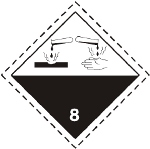You are here:
Corrosive substances: Classification in accordance with the model regulations of the United Nations for the transport of dangerous goods

Dangerous goods with corrosive properties are subject to Hazard Class 8 “Corrosive Substances” of the nine dangerous goods classes of the model regulations of the United Nations and have to be labelled with the corresponding hazard symbol.
Allocation of substances or mixtures to Class 8 is based on the assessment of their corrosive effect on living tissue or the damage of metals. Substances in Class 8 are classified to three packaging groups:
- Packaging Group I (very dangerous substances and preparations)
- Packaging Group II (substances and preparations presenting medium danger) and
- Packaging Group III (substances and preparations presenting minor danger)
Experience is usually taken into consideration when classifying substances in the dangerous goods list of the model regulations of the United Nations. Additional factors, such as a possible inhalation risk or the reactivity of a substance with water causing the formation of dangerous decomposition products, were included in these decisions. The assessment of the effect on metal surfaces is the technical responsibility of the Federal Institute for Materials Research and Testing.
Human experience can be used to assess the hazard of substances and mixtures that are not included in the dangerous goods list, or classification can be performed on the basis of experimental data. The decisive factor for allocating one of the three packaging groups is the period of exposure after which the complete destruction of intact human skin can be expected. This can be determined by animal testing in line with OECD Test Guideline 404 or with a membrane model test in line with OECD Test Guideline 435. A first estimation as to whether corrosive properties even exist which would require classification to Hazard Class 8 is also possible in many cases with the in vitro methods in line with OECD Test Guidelines 430 or 431. Not all methods used up to now which do not involve animal testing enable an assessment which permits allocation to the appropriate packaging groups.
Criteria for packaging
The criteria for the packaging groups correspond to those of the three subcategories of Category 1 for skin corrosive substances when classifying hazardous substances in accordance with the European CLP Regulation.
No calculation method for the classification of mixtures containing components with a known corrosive effect is included in the model regulations, nor are other possibilities for the transfer of information (“bridging rules”) described as they are in the GHS.
Tasks of the BfR
The BfR has published Help for Users who would like to classify substances or mixtures in accordance with the European Chemicals Guidelines.
To evaluate corrosive substances, the BfR collaborates with other authorities and industrial experts in the classification working group of the Dangerous Goods Advisory Board (AGGB) at the Federal Ministry of Transport, Building and Urban Development. It also advises national and regional authorities and comments on general aspects of the hazard classification of corrosive substances in requests to the institute.
Tasks and responsibility of the consignor
The correct classification of goods to be conveyed to hazard classes and the allocation to the appropriate packaging group is within the responsibility of the consignor. This also includes the decision as to whether animal testing is required to assess the corrosive properties of a substance or mixture in compliance with the legal provisions of the EU or whether other methods of hazard assessment can be used with an acceptable level of scientific accuracy (e.g. conclusions by analogy, substance grouping, “bridging rules” as described for mixtures). In several cases, precautionary allocation to a stricter packaging group can also be the best way of avoiding animal testing while taking existing scientific uncertainties into account.
The BfR does not provide the corresponding assessments for manufacturers or forwarders.
Important publications from the BfR:
- Höfer T.: Weniger Tierversuche zur hautätzenden Wirkung chemischer Produkte im Gefahrguttransport. Bundesgesundheitsblatt 10:515-517(1992)
